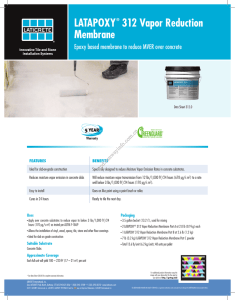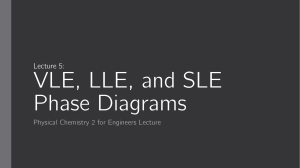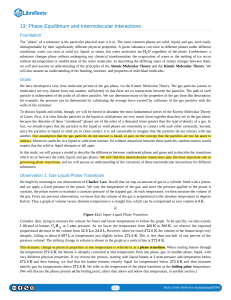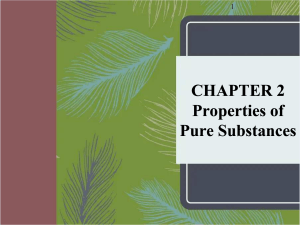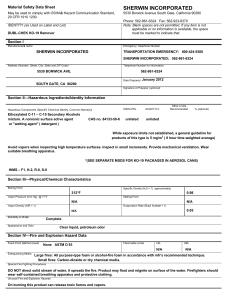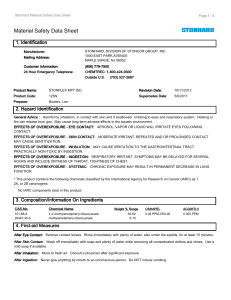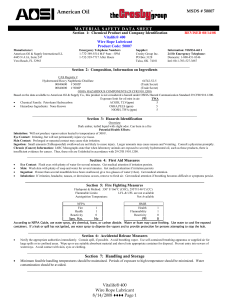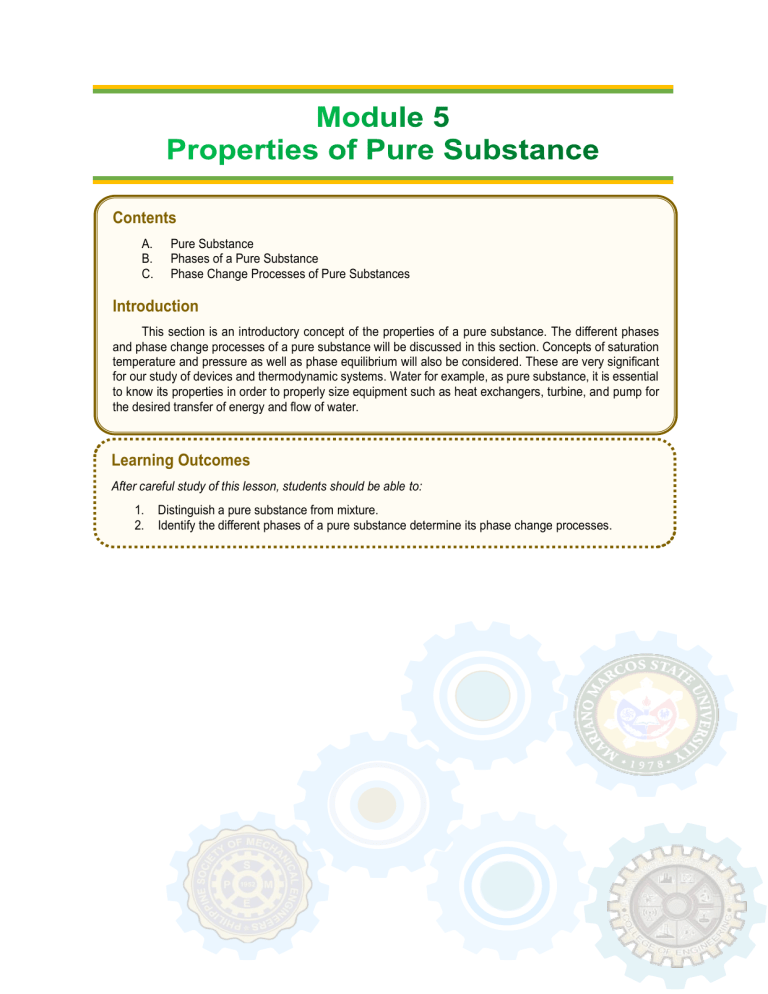
A. 1) 2) Module 5 Properties of Pure Substance Roster Method Set Notation Set Builder Notation B. Set Equality II. Set A. Operations Pure Substance Contents A. B. The Phases a Pure Substanceof Sets Unionofand Intersection C. Phase Change Processes of Pure Substances III. The Set of Real Numbers A. The Natural Numbers E. The Irrational Numbers Introduction This section is an introductory concept of the properties of a pure substance. The different phases B.and phaseThe Whole Numbersof a pure substance will be discussed in this section. Concepts of saturation change processes temperature and pressure as well as phase equilibrium will also be considered. These are very significant C.for our study TheofIntegers devices and thermodynamic systems. Water for example, as pure substance, it is essential to know its properties in order to properly size equipment such as heat exchangers, turbine, and pump for D. The Rational Numbers the desired transfer of energy and flow of water. F. The Real Numbers Learning Outcomes G.After careful Setsstudy of Numbers as Subsets of this lesson, students should be able to: IV. V. A. Real Number 1. The Distinguish a pureSystem substance from mixture. 2. Identify the different phases of a pure substance determine its phase change processes. InequalityI.................................................................................................... Introduction to Sets Set Notation 1) Roster Method 2) Set Builder Notation B. II. A. Set Equality Set Operations The Union and Intersection of Sets III. The Set of Real Numbers A. The Natural Numbers B. The Whole Numbers C. The Integers D. The Rational Numbers E. The Irrational Numbers F. G. IV. V. The Real Numbers Sets of Numbers as Subsets The Real Number System Inequality Chapter 2: Properties of Pure Substance A. Pure Substance A pure substance is one that has an invariable chemical composition like water, helium, nitrogen and carbon dioxide. A mixture of several elements is also considered as pure substance as long as its resulting mixture is homogeneous. If a mixture exists in two or more phase, but the chemical composition is the same in all phases, it is still considered as pure substance. An example is liquid water which is a mixture of liquid water and water vapor (steam), as well as a mixture of ice and liquid water, since every phase has the same chemical composition. On the other hand, a mixture of liquid air and gaseous air is not a pure substance since they are not chemically homogeneous. This is because the composition of the liquid phase is different from that of the vapor phase. Distinguishing between pure substance and a mixture ➢ A pure substance consists only of one element or one compound while a mixture consists of two or more different substances, not chemically joined together (figure 1). Figure 1 The components of a mixture can be separated without chemical reactions ➢ Pure substance has a sharp melting point while mixtures melt over a range of temperatures. This difference is most easily seen when the temperature of a hot liquid is measured as it cools and freezes. Example, the graph (figure 2) shows the cooling curve for a sample of a compound called salol. Figure 2 The temperature stays the same while a pure substance changes state ME 111: Thermodynamics 1 ME Department, COE -MMSU 2 Chapter 2: Properties of Pure Substance B. Phases of a Pure Substance Substances exist in different phases. A phase is known as having a distinct molecular arrangement that is homogeneous throughout and separated from the others by easily identifiable boundary surfaces. There are three different phases of a pure substance: 1. Solid The molecules are closely packed together. They are arranged in a three-dimensional pattern that is repeated throughout (figure 3). Due to the small distances between each molecule, the attractive forces of each are large which keep it at fixed positions. Figure 3 Molecules of solid in 3-D pattern (lattice) 2. Liquid The molecules are no longer at fixed position relative to each other and they can rotate and translate freely (figure 4). The intermolecular forces are weaker relative to solids, but relatively strong compared to gases. Figure 4 Molecular structure of liquid 3. Gas Molecules are far apart from each other and has no molecular order (figure 5). Gas molecules moves in random and continuously colliding with each other and the walls of the container they are in. Molecules are at higher energy level compared to liquid or solid phases. Thus, the gas releases a large amount of its energy before it can condense or freeze. Figure 5 Molecular structure of gas ME 111: Thermodynamics 1 ME Department, COE -MMSU 3 Chapter 2: Properties of Pure Substance C. Phase Change Processes of a Pure Substance Compressed Liquid or Subcooled Liquid (figure 6) It is the phase at which the liquid is non-saturated, means any liquid that it is not about to vaporize. Any addition of heat increases only the temperature of the liquid but does not cause any change of its phase. Figure 6 At 1atm and 200C, water exists in the liquid phase Saturated Liquid In this phase, any addition of heat causes some liquid to vaporize leading to a mixture of saturated liquid and vapor. Figure 7 At 1atm and 1000C, water exists as a liquid that is ready to vaporize. Saturated Liquid-Vapor Mixture Liquid and Vapor phases coexist in equilibrium at these states. Figure 8 Part of the saturated liquid vaporizes ME 111: Thermodynamics 1 ME Department, COE -MMSU 4 Chapter 2: Properties of Pure Substance Saturated Vapor In this phase, the vapor has absorbed more heat than necessary to vaporize it and convert all liquid into vapor. A vapor that is about to condense is called saturated vapor. Figure 9 At 1 atm, the temperature remains constant at 1000C until the last drop of liquid is vaporized Superheated Vapor In this phase, all liquid had converted to vapor and any addition of heat will lead only to hotter vapor. A vapor that is not about to condensate is called superheated vapor. Figure 10 As more heat is transferred, the temperature of the vapor starts to rise The constant pressure phase change process can be illustrated on a T-V diagram shown in figure 11. Figure 11 T-V diagram for heating process of water at constant pressure ME 111: Thermodynamics 1 ME Department, COE -MMSU 5 Chapter 2: Properties of Pure Substance Saturation Temperature and Saturation Pressure Water boils at 1000C when pressure is held constant at 1 atm (101.325 kPa). If say for example we raise the pressure to 500 kPa, then water would start boiling at 151.80C. Thus, the temperature at which water starts boiling depends on the pressure; it follows that if pressure is fixed, boiling temperature is also fixed. At a given pressure, the temperature at which a pure substance changes phase is called the saturation temperature Tsat. Likewise, at a given temperature, the pressure at which a pure substance changes phase is called the saturation pressure Psat. Table 1 shows a list of the saturation pressure against the temperature for water. This table shows that the pressure of water changing phase (boiling or condensing) at 25 0C must be 3.17 kPa, and the pressure of water must be maintained at 3976 kPa to have it boil at 2500C. Likewise, if we drop pressure below 0.61 kPa, the water will be frozen. Table 2 Variation of the standard atmospheric pressure and the boiling temperature of water with altitude Table 1 Saturation (boiling) pressure of water at various temperatures The variation of the boiling temperature of water with altitude at standard atmospheric condition is given in table 2. As indicated, for every increase of 1000m elevation, the boiling temperature drops by 30C. ME 111: Thermodynamics 1 ME Department, COE -MMSU 6 Chapter 2: Properties of Pure Substance Phase Equilibrium Phase equilibrium It is the study of equilibrium which exists between or within different states of matter namely solid, liquid and gas. Equilibrium is defined as a stage when chemical potential of any component present in the system stays steady with time. Phase equilibrium has wide range of applications in industries including production of different allotropes of carbon, lowering of freezing point of water by dissolving salt (brine), purification of components by distillation, usage of emulsions in food production, pharmaceutical industry etc. Solidsolid phase equilibrium has a special place in metallurgy and is used to make alloys of different physical and chemical properties. For instance, melting point of alloys of copper and silver is lower than melting point of either copper or silver. Phase Diagrams Phase diagrams (figure 12) are used to understand the relationship between different phases and are usually represented as the change in the phase of a system as a function of temperature, pressure or composition of the components in a system. This diagram is often called the phase diagram since all three phases are separated from each other by three lines. The sublimation line separates the solid and vapor regions, the vaporization line separates the liquid and vapor regions, and the melting (or fusion) line separates the solid and liquid regions. These three lines meet at the triple point, where all three phases coexist in equilibrium. The vaporization line ends at the critical point because no distinction can be made between liquid and vapor phases above the critical point. Substances that expand and contract on freezing differ only in the melting line on the P-T diagram. Figure 12 Phase diagram for onecomponent system Phase Transitions When matter changes from one state to another it is called phase transition. Fusion/melting It is the phase transition of a substance from solid to liquid form. Melting occurs when something that is solid turns back to liquid state like ice to water. Sublimation It is the phase transition of a substance from solid directly to gas/vapor form. Solid carbon dioxide known as “dry ice” sublimates at room temperature. ME 111: Thermodynamics 1 ME Department, COE -MMSU 7 Chapter 2: Properties of Pure Substance Freezing It is the phase transition of a substance from liquid to solid form. When water turns to ice is a common example. Water becomes cold enough that it turns into ice. In fact, every known liquid except for helium is known to freeze in low enough temperatures. Vaporization It is the phase transition of a substance from liquid to gas/vapor form. Example is the transformation of water to steam in which water is vaporized when boiled where it forms a thick steam. Condensation It is the phase transition of a substance from gas/vapor to liquid form. Example is the transformation of water vapor to dew where water vapor turns from gas into a liquid such as dew on the morning grass. Deposition It is the phase transition of a substance from gas to solid form. Gas can transform directly into solid under certain circumstances. Example is the transformation of water vapor directly to ice without becoming a liquid. Triple point It is the point on the graph where all the three states coexist and is unique for every component. Figure 13 Triple point pressure and temperature where substance exists in three phases in equilibrium Critical point The condition for which liquid and its vapour phases becomes identical and is defined by critical temperature, critical pressure and critical density. ME 111: Thermodynamics 1 ME Department, COE -MMSU 8
